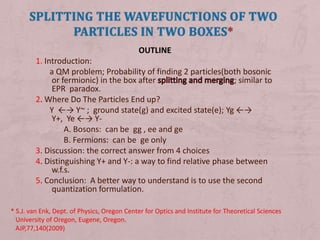Recommended
More Related Content
Viewers also liked
Viewers also liked (16)
Warp Propulsion System by Quantum Entanglement - INFLATIONARY GEOMETRY

Warp Propulsion System by Quantum Entanglement - INFLATIONARY GEOMETRY
Samantha chase, zim williams, retius clark gov final

Samantha chase, zim williams, retius clark gov final
Browsing and Recomposition Policies to Minimize Temporal Error When Utilizing...

Browsing and Recomposition Policies to Minimize Temporal Error When Utilizing...
Evaluating Sliding and Sticky Target Policies by Measuring Temporal Drift in ...

Evaluating Sliding and Sticky Target Policies by Measuring Temporal Drift in ...
Continuous variable quantum entanglement and its applications

Continuous variable quantum entanglement and its applications
Security of continuous variable quantum key distribution against general attacks

Security of continuous variable quantum key distribution against general attacks
Multi-particle Entanglement in Quantum States and Evolutions

Multi-particle Entanglement in Quantum States and Evolutions
Quantum Entanglement - Cryptography and Communication

Quantum Entanglement - Cryptography and Communication
Similar to Report
Let’s face complexity September 4-8, 2017
Complex Dynamics and Statistics in Hamiltonian 1-D Lattices - Tassos Bountis 

Complex Dynamics and Statistics in Hamiltonian 1-D Lattices - Tassos Bountis Lake Como School of Advanced Studies
Similar to Report (20)
Complex Dynamics and Statistics in Hamiltonian 1-D Lattices - Tassos Bountis 

Complex Dynamics and Statistics in Hamiltonian 1-D Lattices - Tassos Bountis
Report
- 1. Splitting the wavefunctions of two particles in two boxes* OUTLINE 1. Introduction: a QM problem; Probability of finding 2 particles(both bosonic or fermionic) in the box after splitting and merging; similar to EPR paradox. 2. Where Do The Particles End up? Y ←-> Y~ ; ground state(g) and excited state(e); Yg ←-> Y+, Ye ←-> Y- A. Bosons: can be gg , ee and ge B. Fermions: can be ge only 3. Discussion: the correct answer from 4 choices 4. Distinguishing Y+ and Y-: a way to find relative phase between w.f.s. 5. Conclusion: A better way to understand is to use the second quantization formulation. . : * S.J. van Enk, Dept. of Physics, Oregon Center for Optics and Institute for Theoretical Sciences University of Oregon, Eugene, Oregon. AJP,77,140(2009)
- 3. the interaction is turned off,
- 4. systems I and II remain correlated(coherent or entangled).
- 5. measurement of observable A on I is done
- 6. If measurement of observable B on I is done:
- 7. What if I and II are far apart? Measuring A or B on I changes II instantly.
- 8. EPR paradox: QM is either incomplete or action at a distance(no causality)is possible*A. Einstein, B. Podolski and N. Rosen, PRV,47,777(1935)
- 10. No non-local effect or entanglement involved
- 11. This is a local effect problem
- 13. Probability of 2 particles in WL and SR, Pws=? Particle 2 Note: 0<x1,x2<2L before splitting 0<x1,x2<L and L<x1,x2<2L after splitting
- 14. For Classical distinguishable particles 25% 2 WS 25% 2 SW 50% 1 WS + 1 SW Pws =1/4
- 15. Identical quantum particlesbosonic and fermionic? The answer is …… P = ¼ because only particle numbers are concerned, no other Q.#s Bosons together, P = ½ Fermions expells , P = 0 3. Exchange particles, same as color repainted, no actual change, P= 0 for B and F. 4. P=0 for Boson as in 3; P=1/2 for Fermion because minus sign of w.f.
- 16. W.F. describing 2 particles in 2 boxes where S is symmetrization operator or anti-symmetrization operator. After splitting the boxes, w.f. is : Multiply terms, So, you can see P=1/4 is the correct answer!
- 17. Yg Ye Y+ Y- However, excited state and ground state are degenerate after splitting the box. Take the 2nd term of Eq. (3) of the splitted boxes
- 20. Can you tell actually which one it is?Prepare a 2nd box, say Y+. Then merge two halves on each side . We will have ……….
- 22. We can tell which one,Y+ or Y-, is given to us if wemeasure the states of the 2 particles.
- 23. conclusion Summary and some key points References
